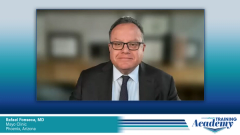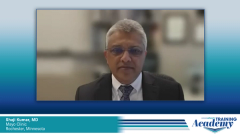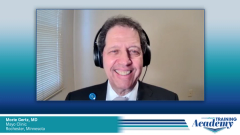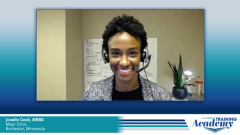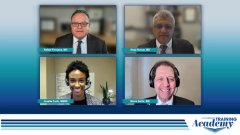
MonumenTAL-1: Data Updates of Non-BCMA Bispecifics in MM
Shared insight from Rafael Fonseca, MD, on data from MonumenTAL-1 and the use of talquetamab therapy in patients with relapsed/refractory multiple myeloma.
Episodes in this series

Transcript:
Rafael Fonseca, MD: Before I go to Dr Gertz, I will make some comments about another product that we're very excited about, talquetamab. It's in a clinical trial that was presented by Dr Chari, the MonumenTAL-1 clinical trial. The reason I think this is particularly exciting is because now we're looking at a different target than BCMA [B-cell maturation antigen], and this target is GPRC5D [G protein-coupled receptor family C group 5 member D]. GPRC5D has very significant specificity toward B cells, although it's important to recall, it can be expressed at lower levels in other tissues, including teguments such as skin, lining of the mouth, and so forth. This will be important as we talk about its toxicity. This particular clinical trial that Dr Chari presented is a phase 1 trial. They also presented a summary of patients that were treated at the recommended phase 2 dose. Now, for patients to be enrolled they needed to have 3 or more prior lines of therapy. And I’d like to, again, bring this up for further conversation, because we're thinking more and more about exposure to drugs rather than lines of therapy. But these patients required exposure to a proteasome inhibitor, an IMiD [immunomodulatory drug], and at least one of the anti-CD38 monoclonal antibodies. And this antibody can be administered in a subcutaneous fashion. When they reported these data, they had 288 patients that had no prior exposure to any of the T cell–redirecting therapies, and received talquetamab at the recommended phase 2 dose. 143 patients had received it at the dose of 0.4 mg/kg (or 400 mcg/kg). As you can imagine, these patients had prior treatment. The median lifetime therapy was 5. A high number of patients had high-risk cytogenetics, and many of them were either triple-class exposed or refractory. What they reported was also quite impressive; an overall response rate of 73%. We've heard before that 60 and 70 is the new 20. We used to say 20% overall response rate caught our eye as we thought about activity against multiple myeloma. But we're seeing now with the phase 1 studies and these types of therapies that were sometimes, and often with the bispecifics, in the range of 60% to 70% with a quick response. Most patients responded within a couple of months. It’s something that quickly shows activity against the disease. The primary endpoint for this trial was the overall response rate, but they reported a PFS [progression-free survival] of 7.5 months for these patients who had the triple-class refractory. But then as we see some patients that are responding, we can see patients that have very, very durable responses. The AEs [adverse events], I won't go much into the details, but patients did experience CRS [cytokine release syndrome], as we know happens with all these therapies, in the range of 79%. But in particular, I think what's unique about this therapy is that skin-related AEs occur in about two-thirds of patients, and that includes both tegument changes, nail disorders, as well as dysgeusia, which is a change in the ability of patients to perceive taste. So, I think we're following this with great excitement, but it's 1 more option of a bispecific that now targets GPRC5D.
Transcript edited for clarity.
Newsletter
Stay up to date on recent advances in the multidisciplinary approach to cancer.


